U.S.S. Enterprise Science Section
Created by Commodore Wilkan Targaryen on Sat Aug 17th, 2024 @ 6:14pm
Laboratory
The Constitution IV Class has been designed with exploratory missions as a priority. To accomplish this discovery-oriented role, over one hundred separate scientific research labs have been installed aboard the vessel. Typically, laboratories aboard Starfleet vessels rarely remained assigned to the same scientific discipline for more than six months; however, based upon long-term research, the Enterprise was designed to feature several laboratories for long periods.
Anomaly Storage Room
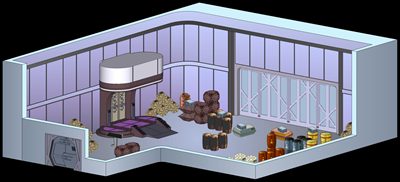 The Anomaly Storage Room (also called the Anomaly Room) was a specialized compartment on Federation Constitution IV Class starships where objects awaiting further study or return to their previous entities were stored. Access to the Anomaly Storage Room was restricted to Lieutenants (Junior Grade) or higher, due to the dangerous nature of the objects stored there.
The Anomaly Storage Room (also called the Anomaly Room) was a specialized compartment on Federation Constitution IV Class starships where objects awaiting further study or return to their previous entities were stored. Access to the Anomaly Storage Room was restricted to Lieutenants (Junior Grade) or higher, due to the dangerous nature of the objects stored there.Located on Deck 39 of the Stardrive Section, the Anomaly Storage Room was a converted Cargo Bay. The upper level of the room was located on Deck 38 and featured a small control room that overlooked the room. To better protect the crew, the Anomaly Room was fitted with a Cargo Transporter that could be used to transport an anomaly from the vessel without risking exposure to the crew. Anti-gravity units and Tractor Beam Generators were fitted to assist in moving large containers, while airlock doors were present to allow the room to be opened into space.
Arboretum
 The Arboretum aboard the Starship Enterprise is a botanical garden composed exclusively of trees and shrubs of a variety of species from multiple worlds. One of the largest locations aboard the Enterprise, the Arboretum has multiple functions aboard the starship and is considered both a recreation area where crewmembers could relax and as an area of scientific research. Further, due to the presence of a variety of plant life within the compartment, the Arboretum supplements the life-support systems of the Enterprise and assists in maintaining atmosphere aboard the craft.
The Arboretum aboard the Starship Enterprise is a botanical garden composed exclusively of trees and shrubs of a variety of species from multiple worlds. One of the largest locations aboard the Enterprise, the Arboretum has multiple functions aboard the starship and is considered both a recreation area where crewmembers could relax and as an area of scientific research. Further, due to the presence of a variety of plant life within the compartment, the Arboretum supplements the life-support systems of the Enterprise and assists in maintaining atmosphere aboard the craft. When new personnel were assigned to the Enterprise the arboretum was one of the locations that they were given a tour of by their Department Head. Focusing on low-intensity recreation, the Arboretum emphasizes an open-space plan that includes rustic picnic areas, benches, and trails. Currently, the Enterprise's Arboretum features a small pond and different types of plant life, including Cypirion cactus and roses, which includes endangered plant-life varieties. Among the most prized flora within the Enterprise's Arboretum is a Beauregard Weeper from the planet Zeta Reticuli A, a descendant of the same species as "Gertrude" of the USS Enterprise NCC-1701.
Astrometrics Laboratory
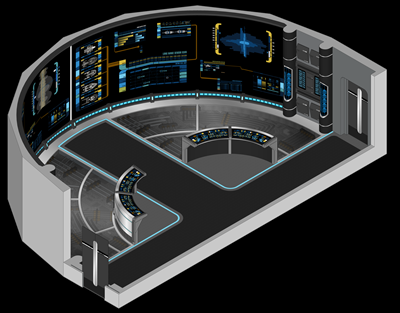 Assigned to Starfleet vessels since the Enterprise NX-01, the Astrometrics Laboratory was a specialized lab used for stellar cartography purposes.
Assigned to Starfleet vessels since the Enterprise NX-01, the Astrometrics Laboratory was a specialized lab used for stellar cartography purposes. Similar in design to the Navigational Control Room aboard the Enterprise, Astrometrics incorporates lessons learned from the works of Captains Harry Kim and Seven of Nine. Incorporating Borg technology, Astrometrics was used for charting stars, planets, nebulae, and other stellar bodies and determine the ship's position relative to the galactic core. The lab itself contained a large, wraparound, holographic wall screen that could display any information visually. For convenience or advanced analysis, the display could be used for communications purposes or even as a workplace for easy access to sensor information. A direct link with Starfleet Cartography could be established through the Astrometrics Lab; however, interference from nearby astronomical phenomena could interfere with such communications. A series of control panels were located centrally that could be used to access information and control the display screen.
Working closely with the vessel's pilots and Stellar Cartrography, Astrometrics is always manned.
Astrophysics Laboratory
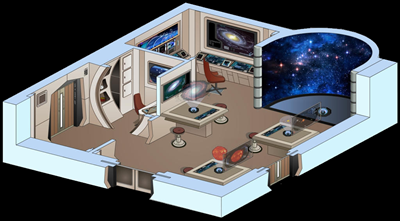 The Astrophysics Laboratory was a lab aboard the Enterprise dedicated to the study of astrophysics, a branch of astronomy that dealt with the physics of celestial objects in the universe.
The Astrophysics Laboratory was a lab aboard the Enterprise dedicated to the study of astrophysics, a branch of astronomy that dealt with the physics of celestial objects in the universe. Operated by trained Astrophysicists, the Astrophysics Lab incorporates a large holotank that allows users to create a scaled holographic replica of a subject for further study. A series of workstations line the walls of the lab, allowing scientists priority access to the shipboard computer system to process and proceed with experiments. Like the holotank, holographic emitters have been embedded within several of the workstations for use in presenting and analyzing data. Additionally, a small, private work area is available within the lab for the senior astrophysicist to work on personal projects, review the work of other scientists, or communicate with other personnel.
Cetacean Ops
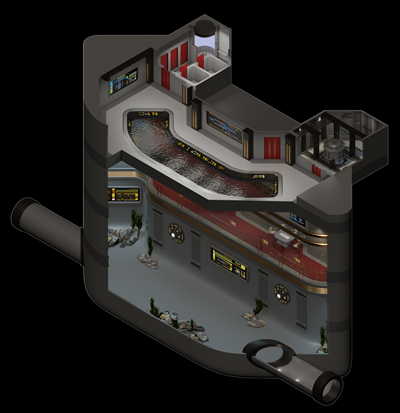 Cetacean Ops is a research facility aboard the U.S.S. Enterprise that specializes in stellar research and navigation. The largest scientific research center aboard the Enterprise, Cetacean Ops comprises an aquarium center (referred to as the "Lagoon") used by various cetacean crewmembers and a collaboration area used by humanoid personnel to interact with the cetaceans.
Cetacean Ops is a research facility aboard the U.S.S. Enterprise that specializes in stellar research and navigation. The largest scientific research center aboard the Enterprise, Cetacean Ops comprises an aquarium center (referred to as the "Lagoon") used by various cetacean crewmembers and a collaboration area used by humanoid personnel to interact with the cetaceans.The cetacean area of the Cetacean Ops compound was submerged in water and featured a specialized navigation lab, crew quarters, and four cetacean lifeboats that spanned multiple decks. Humanoid personnel operating in Cetacean ops can choose to interact with aquatic personnel in one of two ways. By visiting the surface collaboration area, personnel first pass through an entrance hall that provides information on the evolution of marine life on Federation's Founding Worlds and then opens into a large chamber that incorporates a moon pool allowing entry into the lagoon. Workstations line the moon pool for use by the cetacean crewmembers, as well as standard wall mounted consoles available to the humanoid visitors. A nearby maintenance room allows access to the machinery that maintains the lagoon.
For enhanced collaboration, environmental suits were available for personnel to wear to enter the lagoon to interact with the cetaceans one on one. The subaquatic collaboration area allows for humanoid personnel to work directly with aquatic crewmembers from workstations built directly into the lagoon. Large table-based workstations were provided with seats and appropriate computer terminals for use by both aquatics and humanoids.
Chemistry Laboratory
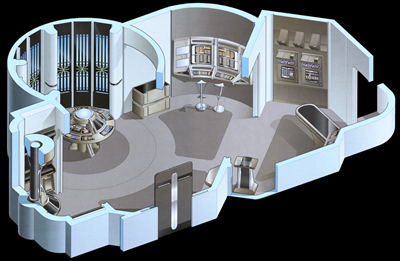 The Chemistry Laboratory, also known as the Chem Lab, is a specialized lab on the Enterprise that studies different chemicals and chemical reactions encountered during exploratory assignments.
The Chemistry Laboratory, also known as the Chem Lab, is a specialized lab on the Enterprise that studies different chemicals and chemical reactions encountered during exploratory assignments. The Chemistry Lab on the Enterprise was a large space with a variety of specialized science stations located throughout the room for usage in experiments and investigations. A circular analysis table was the primary feature of the Chem Lab and was a critical component of any experiments launched in the lab. An enhanced interface and investigations console was located adjacent to the analysis table, providing up to the minute reports on any experiment being conducted. In addition to these computer terminals, the lab was also fitted with cutting edge scientific equipment that could be used to conduct a variety of tests on samples brought back from assignments.
Cybernetics Laboratory
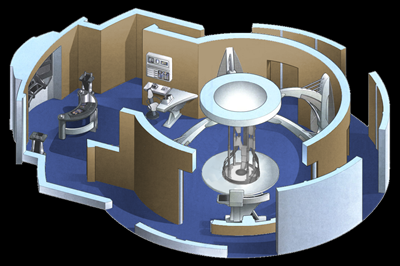 Used in the study of hugely complex artificial intelligence systems and robotics, the Cybernetics Laboratory aboard the Enterprise is a specialized scientific research center manned by a team of highly trained Cyberneticists.
Used in the study of hugely complex artificial intelligence systems and robotics, the Cybernetics Laboratory aboard the Enterprise is a specialized scientific research center manned by a team of highly trained Cyberneticists.Circular in shape with an attached anteroom, the Cybernetics Lab was is a restricted area aboard the Enterprise. Located in the center of the room, a Cybernetic Research Table has been installed that can be used for the analysis of cybernetic equipment. A specialized shell, the table incorporates advanced sensor technologies and could retract into a ceiling housed imaging chamber that allowed for more intensive scans. Freestanding computer terminals were located in this circular chamber and were capable of completing multiple investigative functions and related activities. Attached to the surgical chamber, a small anteroom contains additional monitoring workstations for the cyberneticists.
Exobiology Laboratory
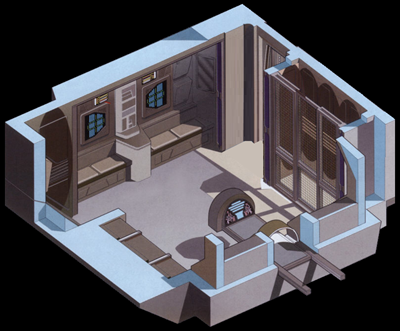 Exobiology (also called astrobiology or xenobiology) is the biological science concerned with examination of living alien organisms and works closely with the Medical Laboratories aboard the Starship Enterprise. Overseen by exobiologists and xenoanthropologists, exobiology is a potentially dangerous field of study aboard the Enterprise and the lab complex incorporates multiple safeguards to protect both the investigators and their subjects. In addition to the ability to generate protective forcefields, the Exobiology Lab has priority access to environmental control functions and general anesthetic, such as anesthezine gas, can be released in seconds.
Exobiology (also called astrobiology or xenobiology) is the biological science concerned with examination of living alien organisms and works closely with the Medical Laboratories aboard the Starship Enterprise. Overseen by exobiologists and xenoanthropologists, exobiology is a potentially dangerous field of study aboard the Enterprise and the lab complex incorporates multiple safeguards to protect both the investigators and their subjects. In addition to the ability to generate protective forcefields, the Exobiology Lab has priority access to environmental control functions and general anesthetic, such as anesthezine gas, can be released in seconds.Despite its importance, the Exobiology Lab aboard the Enterprise is one of the smaller research centers aboard the vessel. The primary feature of the Exobiology Lab is the examination table. Similar to a biobed, the exam table allows analysis of biological samples brought aboard for further investigation. The table is connected to an imaging chamber capable of completing comprehensive body scans or to place samples into biomolecular stasis. When not in use the Examination Table retracts into the imaging chamber, giving additional open space for workers. To better support operations, freestanding workstations are not available in the Exobiology Lab and have been replaced by wallmounted terminals. Flat bench seats are available below the computers that can be used by scientists during their investigations. A secure storage cabinet, located to the left of the exam table, is available to store equipment and investigative tools should they be needed.
Greenhouse
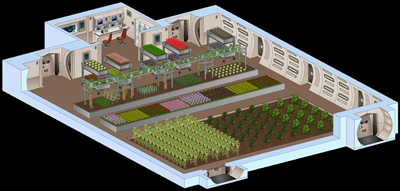 The Greenhouse aboard the Starship Enterprise is a specialize laboratory that facilitates the growth of plants in inhospitable environments.
The Greenhouse aboard the Starship Enterprise is a specialize laboratory that facilitates the growth of plants in inhospitable environments.Originally constructed as a Cargo Bay, the Greenhouse features variable environmental controls that combine specialized airponic and hydroponic equipment. The airponics equipment utilized suspended growing mediums to cultivate plants and fungi while the hydroponics equipment grow plants in a non-soil medium.
The main goal of the Greenhouse was to provide edible vegetation that might alleviate the drain on energy resources caused by replicating food aboard a starship. In addition to standard fruits and vegetables, the Greenhouse on the Enterprise also incorporates Antarian Moon Blossoms, Bantan (a spicy vegetable brought from the Delta Quadrant by Voyager) and Tamarian Defrin Root. With the presence of a swamps area beneath the Greenhouse special precautions have been taken due to the high levels of ambient nitrous oxide needed by the Defrin Root.
Laboratory (Configurable)
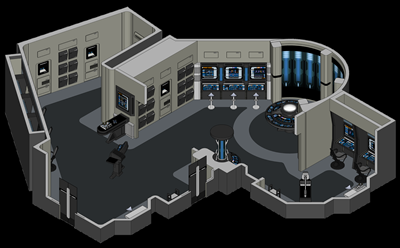 Constitution IV Class starships, like the Enterprise-H, have been equipped with thirty general-purpose Science Laboratories scattered throughout the vessel. A Laboratory provides controlled conditions in which scientific or technological research, experiments, and measurement could be performed. Divided into sections, multiple different experiments and investigations could be launched from the configurable lab concurrently.
Constitution IV Class starships, like the Enterprise-H, have been equipped with thirty general-purpose Science Laboratories scattered throughout the vessel. A Laboratory provides controlled conditions in which scientific or technological research, experiments, and measurement could be performed. Divided into sections, multiple different experiments and investigations could be launched from the configurable lab concurrently.Sharing the same basic design (with some having specialized equipment), configurable laboratories aboard the Enterprise work in experimental or observational science duties. The configurable Science Lab is dominated by a large analysis table located within a sensor alcove. Comprised of multiple workstations for scientific investigation, the alcove can be isolated from the rest of the lab with forcefields in an emergency. A variety of additional workstation consoles are built into the walls of the laboratory, offering seated workspaces for scientists away from the primary console. Located around the periphery of the room, multiple storage compartments house equipment and supplies for use by scientists. A trolley allows for the quick movement of supplies around the room as needed for projects.
Due to the critical nature of the Science Labs and their operations, multiple safeguards are in place to protect the ship and crew from research projects run amok. Each lab can be quickly isolated from the rest of the ship via forcefield should a threat emerge, while anesthetic gas can be released to contain biological threat. In a last-ditch effort to prevent risk the entire lab can be vented into space.
Planetary Sciences Laboratory
 The Planetary Sciences Laboratory, also referred to as Geosciences, was a specialized laboratory on the Starship Enterprise devoted to the study of non-stellar celestial bodies, such as planets, planetoids, asteroids and moons. Assigned to diverse investigations, the Planetary Sciences Lab would be involved in complex investigations that included Geology, Meteorology, and Oceanography to name a few of its responsibilities.
The Planetary Sciences Laboratory, also referred to as Geosciences, was a specialized laboratory on the Starship Enterprise devoted to the study of non-stellar celestial bodies, such as planets, planetoids, asteroids and moons. Assigned to diverse investigations, the Planetary Sciences Lab would be involved in complex investigations that included Geology, Meteorology, and Oceanography to name a few of its responsibilities. A specialized laboratory, Planetary Sciences contains sensitive equipment that is on the cutting edge of science. The main console in the Planetary Sciences Lab was a circular analysis table that was tucked away in an alcove lined with an advanced sensor grid. A curved computer terminal supplemented the analysis table, offering quick access to detailed readouts from the Enterprise's sensors. Additional computer terminals and storage compartments lined the walls, offering workspace for a large number of planetary scientists.
Located in the corner of the Planetary Sciences Lab, a holotank allowed scientists to replicate a planetary environment or related subject for further investigation. A large workstation was mounted against the hologrid to allow scientists access to the main computer and associated libraries for further study. In an emergency the holotank could be isolated by forcefields for added protection for the ship and crew.
Stellar Cartography Laboratory
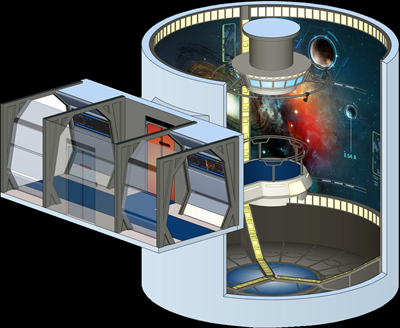 The Stellar Cartography Laboratory on the Starship Enterprise is dedicated to the science and practice of charting planets or space. Combining responsibilities for astrometric surveys, Stellar Cartography was used for charting stars, planets, nebulae, and other stellar bodies and for determining the ship's position relative to the galactic core.
The Stellar Cartography Laboratory on the Starship Enterprise is dedicated to the science and practice of charting planets or space. Combining responsibilities for astrometric surveys, Stellar Cartography was used for charting stars, planets, nebulae, and other stellar bodies and for determining the ship's position relative to the galactic core.A large room spanning three decks aboard the Constitution IV Class, the Stellar Cartography Lab is relatively the same as the first holographic lab established aboard the Galaxy Class. Controlled from a platform located on the middle level of the lab, Stellar Cartography's holotank allows users to gain a panoramic view of the region surrounding the vessel via holographic technology. While primarily used by scientists and navigators, Stellar Cartography can be used by the vessel's strategists in order to prepare for potential combat as well.
Categories: No categories found